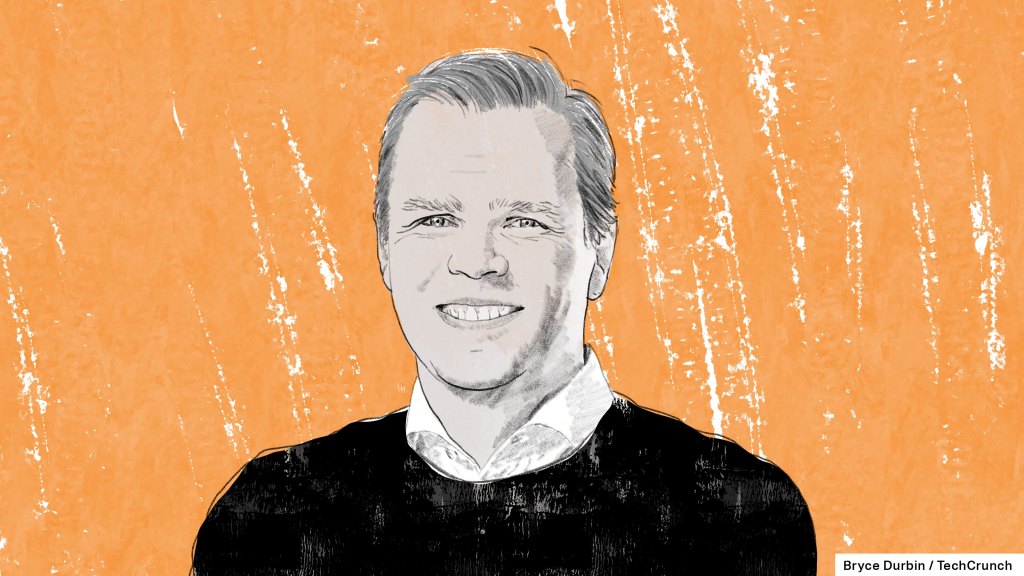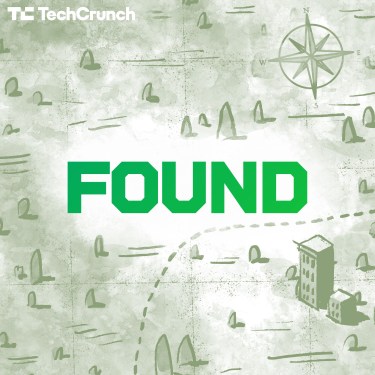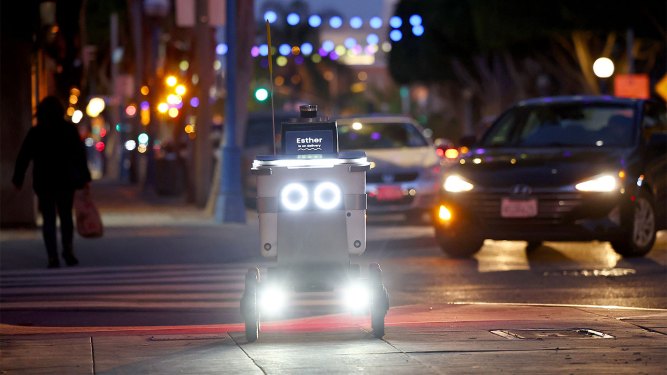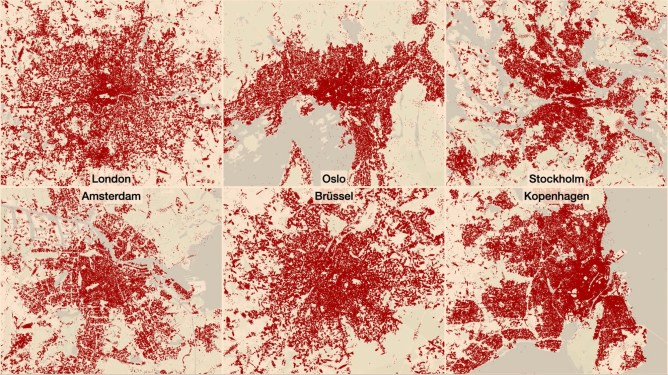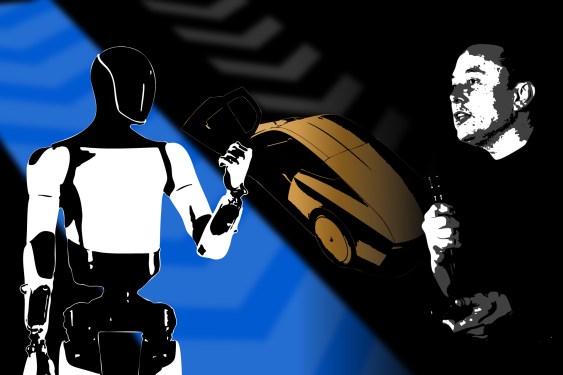Swedish startup Einride was founded in 2016 with a mission to electrify freight transport. Today, that means designing electric trucks and an underlying operating system to help overland shippers make the transition to electric. In the future, it will mean deploying electric autonomous freight — more specifically, Einride’s autonomous pods, which are purpose-built for self-driving and can’t accommodate human drivers.
Einride founder and CEO Robert Falck told TechCrunch a year ago that he felt a moral obligation to create a greener mode of freight transport after spending years building heavy-duty diesel trucks at Volvo GTO Powertrain. On top of that, he saw the need to eventually automate the role of long-haul trucking.
Falck, a serial entrepreneur, decided against the route many autonomous trucking companies have taken — doggedly pursuing self-driving technology, even if it meant putting sensors and software stacks on diesel vehicles. Rather, Falck chose a two-step process to bring Einride to market. The first involves working with OEM partners to build electric trucks and partnering with shippers to deploy them and earn revenue. That revenue then goes back into the business for the second step, which is the development of an autonomous system. By the time Einride is ready to go to market with its autonomous pods, it will ideally already have a range of commercial shipping partners in its pipeline.
Einride’s current shipping clients across Sweden and the U.S. include Oatly, Bridgestone, Maersk and Beyond Meat. The company said it clears close to 20,000 shipments per day.
Over the past few months, Einride has completed a public road pilot of its electric, autonomous pod in Tennessee with GE Appliances, launched its electric trucks in Germany in partnership with home appliance giant Electrolux, announced plans to build a network of freight charging stations in Sweden and Los Angeles, and introduced its second-generation autonomous pod.
We sat down with Falck a year after our initial interview with him to talk about the challenges of reaching autonomy when connectivity on the roads is lacking, why the Big Tech crashes are actually healthy for the industry and what consolidation looks like for autonomous driving.
The following interview, part of an ongoing series with founders who are building transportation companies, has been edited for length and clarity.
TechCrunch: Einride’s end game is to deploy autonomous electric freight, but you’re putting manually driven electric trucks on the market now. Is that just because it’s a more direct route to market?
Robert Falck: Yeah, definitely. But at our core, what we do is provide transport service capacity for our clients and give them the option to ship in a sustainable and cost-competitive way. For us, that has always been the goal. You can do that either with manual electric or electric autonomous. So I mean, in many ways, we have more in common with players like Uber than we have with classical OEM or truck manufacturers.
More in common with players like Uber? How so?
Because our clients are the shippers, and they depend on different transport service providers. If you look at the goods industry today, it’s very similar to where the taxi industry was in 2005, in the sense that no one has really connected the technology and the platforms into a system serving the shippers.
By that logic, your operating system Saga, which does fleet management and optimization, is actually your core product?
Correct. We started the company with the ambition to provide and develop the operating system to tie all this together. And the thing is that if you want to have an operating system, you need to have hardware to run it on. So we’ve been all-in on making the future happen. When we launched the pod, we needed a platform to run it on, so we developed that platform because no one else did. The same goes for our electric manual trucks.
At our core, we are a tech company. We’re taking the same approach on hardware as other major tech companies like Google, Nvidia, Apple, in that we design and develop the tech and then we utilize manufacturing partners to actually produce it.
Because of that, we are currently one of the biggest, if not the biggest, buyers of electric trucks in the world right now.
You’re now working on a new autonomous pod design, and you recently completed your pilot in the U.S. What did you learn from that?
Autonomous is still going to take some time and effort. For us, autonomous has always been a long game, and we have taken a different route than a lot of the other players that are in the autonomous space. Our plan since the start has been to provide the platform, the capacity and the service of access to this new technology. So the gradual transition to autonomous, when the technology matures, is something that’s built into the strategy and built into the company. So we’re not intending to make autonomous applicable for every application next year or in 2024. We are scaling profitable clients and contracts, so our goal now is to keep selling the capacity. Once we have the opportunity to replace more and more of our installed capacity with autonomous, we’ll be able to increase the margins quickly.
More Transportation Founders
Sila’s Gene Berdichevsky on the ‘5-year roller coaster’ facing battery companies
Treepz founder Onyeka Akumah on how to succeed in transportation tech
Drover AI’s Alex Nesic on using tech to regulate the scooter market
Zūm founder strikes balance between accessibility and a massive logistics network
Empathy is essential for building a loyal team, says Kolors co-founder Anca Gardea
Kodiak Robotics’ founder explains why autonomous freight could brush off inflation
Veo’s Candice Xie one year later, still slowly and steadily winning the profitability race
Astrix Astronautics’ Fia Jones on wooing Peter Beck to launch her startup
Why Convoy’s Dan Lewis expects digital freight to go mainstream within the year
Revel founder Frank Reig a year later on driving EV adoption in big cities
Steer’s Anuja Sonalker explains the benefits of chasing the less glitzy side of autonomy
Co-founders of Ukrainian startup Delfast discuss navigating through a crisis
Tortoise co-founder Dmitry Shevelenko: ‘You can’t do too many things at the same time’
Waabi’s Raquel Urtasun on the importance of differentiating your startup
Exploring the many faces of sidewalk delivery robots with Cartken’s Anjali Jindal Naik
Einride founder Robert Falck on his moral obligation to electrify autonomous trucking
Via’s Tiffany Chu on the importance of govtech for planning mobility ecosystems
Rad Power Bikes founder Mike Radenbaugh on fueling the e-bike revolution
Battery chemistry company Sila’s founder Gene Berdichevsky on the science of scaling up
Plentywaka founder Onyeka Akumah on African startups and global expansion
Zūm CEO Ritu Narayan explains why equity and accessibility works for mobility services
Kodiak Robotics’ founder says tight focus on autonomous trucks is working
Outdoorsy co-founders detail how they expanded the sharing economy to RVs
Veo CEO Candice Xie has a plan for building a sustainable scooter company, and it’s working
Refraction AI’s Matthew Johnson-Roberson on finding the middle path to robotic delivery
Arrival’s Denis Sverdlov on the new era of car manufacturing
Revel’s Frank Reig shares how he built his business and what he’s planning
What needs to be improved on the autonomous vehicle tech front before you can commercialize?
I think that connectivity is going to be one of the major challenges overall. Since we don’t have a safety driver in the vehicle, we depend heavily on technology in the vehicle.
I wouldn’t say we were surprised, but the U.S. and Europe are both a long way from getting the connectivity support that’s required to make any at-scale autonomous deployment happen in any context.
There’s room for both new players and new solutions in connectivity, and the market today is not mature enough when it comes to high-quality connectivity solutions. I mean, if you drive down Menlo Park up to San Francisco, you’re not able to stick on one call. Imagine if you need to get access to your truck or car, and you’re in a dead zone.
A lot of those kinds of things are actually more challenging than you think when you’re deploying autonomous as a real business case. A lot of companies don’t necessarily consider that when they have a safety driver in the vehicle, but once you remove that, a lot of those practical, non-obvious things become very pressing. For instance, if you have a malfunction and are not connected, you literally won’t know where the vehicle is.
Is it dangerous or problematic enough that you might consider building a seat for a safety driver until the tech develops? Or would you rather put money toward building better connectivity?
Building connectivity. Because as long as you have the human as an option in the loop, you’re going to design the system that way. If you actually design it fundamentally without the option for the human to take over, the whole logic for the system becomrs extremely different.
Is there not a human built into the loop in Einride’s pods? You have remote pod operators.
The difference is our system is built to bring the truck into a safe state in the event of a disengagement. Other companies rely on the safety driver to take over the vehicle and bring it to a safe state when there’s a disengagement, but you can’t rely on that because then you’ll need to prove your tech doesn’t disengage at all in order to take the driver out.
Our remote operators take over to make decisions and assess what needs to happen. For instance, if for some reason you’re locked into a situation where you’re making a left turn but a truck has driven in front of you and is standing still, that’s a problem that humans are still better at solving. Or if you drive up to the gate, and it doesn’t open, what do you do? An autonomous truck wouldn’t know, so should you develop an AI that can handle what happens when a gate is closed? That wouldn’t be practical.
I assume you’ll need more funds to address some of these issues. You last raised $110 million in May 2021. How are you thinking about fundraising in today’s environment?
It’s tough, but it’s also defining. If you look at the big tech companies today — Tesla, Amazon — they were all born 20 years ago or so in the Dark Ages after the crashes in the early 2000s. It was tough for the whole tech industry and took almost 10 years to recover. But from my perspective, as a tech company, you need to be really good at what you want to do and keep pushing to build a company. So I think the current environment is quite healthy because a lot of capital has been going into things that couldn’t fly, literally. The climate today is just the industry maturing, and new technology is being questioned. It’s about making real numbers happen now.
Thoughts on the Argo AI shutdown? How will that affect the industry at large?
A lot of the funding that went into this industry hasn’t been realistic, so again this is actually very healthy. I’m a strong believer of the market adjusting according to the actual performance of both companies and the industry. What’s happening now is a consolidation, and out of that consolidation, the winners will come.
Do you see more consolidation in the future?
I wouldn’t say I’d be surprised if one or two autonomous companies survived, but I think it will be very tough to be a sole autonomous player. It’s hard to have a core technology that is future oriented without the underlying business for it.
Would you say the same for the recent Ouster and Velodyne lidar merger?
There have been so many companies going after lidar applications. In 2019, I had one lidar company contact me literally every day. So many of them didn’t have any previous experience with the automotive industry and didn’t know what it meant to be a supplier of a component.
On top of that, a lot of lidar technologies were commoditized quite early, and with a lot of future tech, but at the core, there was not enough demand for it. We still don’t have any major buyers of autonomous technology yet.
If you compare the cost of operating a truck by a driver, say the driver is paid $40 per hour on average. That means the tech that replaces the driver, if it’s to be competitive, should be at least 50% less than that. But the current price for an autonomous stack, based on all the components you need and the business plans for startups in this field, is like $3,000, $4,000 per hour. So there are not a lot of realistic business cases out there.
How do you expect to keep Einride in the game? Where do you want to be in a year?
One of my most important goals that we hit this year is $100 million in annual recurring revenue. That’s something we’re very proud of. Another goal is to continue to be the biggest buyer of autonomous electric trucks in the world. By next year I want to hit $2 billion in contracted revenue.
